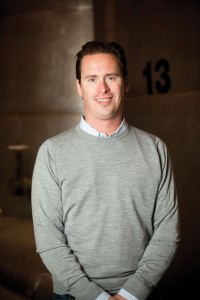It’s all in the family
By: Devin Mulertt

Photo submitted by: Ryan Downs
More than 100 years ago, in the town of Bear Creek, Wis., two Irish brothers began a pickling company called Flanagan Brothers. Since then, Dave and Henry Flanagan’s enterprise has become the world’s largest producer of sauerkraut, processing nearly 150,000 tons of raw cabbage into kraut each year.
Ryan Downs currently leads the business founded by his great-grandfather and great-uncle. Now called GLK Foods, LLC the company operates a second manufacturing facility in Shortsville, N.Y., but maintains its original manufacturing plant and headquarters in Wisconsin. Honoring the achievements of the past while exploring innovations for the future, Downs shares plans for continuing his family’s tradition of success in Wisconsin.
What possessed two Irishmen to start making sauerkraut?
It actually started as a pickling company, processing pickles, with some cabbage on the side. One year the cabbage market was inundated, so they decided they were going to turn it into sauerkraut. It wasn’t some great master plan, it just kind of evolved.
We actually used to have our own freight company that was called Flanagan Brothers Trucking Co., and on the sides of all the semi-trailers it said, “Flanagan Brothers Sauerkraut. Flanagan?” To your point, what the hell are some Irish guys doing making sauerkraut.
What was the early business like, and how did it evolve over time?
They ran the business for basically the whole 20th century. It was a successful business, but there were so many more competitors at that time. Sauerkraut used to be a lot like cheese where there was a little shop on almost every corner in every small town. And people ate a lot more sauerkraut then, too, a trend I would like to go back to. It was a business that succeeded and did well, but we really ramped up our capabilities. And now that we’ve acquired other businesses and attained that critical mass, it’s a much more exciting business to be a part of, but a lot of that consolidation didn’t occur until the mid-to-late nineties.
What plans are in the works to convert more Americans to being kraut-eaters?
The difference in the United States and Canada, versus, for example, Eastern Europe, is here we pretty much eat it as a condiment. Other places, it’s seen as a center of the plate type item. The trick is just to get people to try it. Kraut’s a “super food,” and a lot of people don’t know that, so we just have to find ways to get that word out there. Typically what people eat with sauerkraut in the U.S. isn’t healthy. It’s a brat or it’s a hot dog, so you kind of get lumped in with that, and I think that’s partially why it’s a bit of a hurdle in people’s minds to realize that the kraut itself is very healthy. So it’s incumbent on us to show them other ways to use it.
Last year, at the Fancy Food Show in San Francisco, one of the top trends identified for the coming few years was the resurgence of pickled vegetables, particularly artisanal sauerkraut. So, all of the sudden we’ve gotten this boost of kind of a groundswell of activity. Everybody’s fancying themself a foodie, and everybody’s into this returning to more simple foods, which sauerkraut is. We’d never heard “cool or trendy” and sauerkraut in the same sentence before, so we got pretty excited. So that’s one thing we’re doing to boost consumption and capitalize on the movement that’s already afoot in the U.S.
What makes Bear Creek one of the finest cabbage growing areas in the world?
In Wisconsin, we plant a lot of the cabbage in between Bear Creek and Shiocton. It’s a glacial lakebed, and it’s great soil for growing cabbage. Some of our counterparts in Europe have a longer growing season, but the quality of the soil we grow on is topflight, so we’re able to get what we need.
What kind of relationships does GLK Foods, LLC have with the Bear Creek community and the Wisconsin community?
We sponsor sauerkraut festivals and goofy stuff like that. We give cabbage for this event in Shiocton that they have called the Cabbage Chuck, where they take these enormous catapults and shoot cabbages miles. It’s insane.
Most of our sales occur east of the Mississippi—the Eastern Seaboard is the single biggest market. But they eat a lot of kraut here in Wisconsin, as well. And there’s a lot of people of German decent here in the area. Sauerkraut’s just something that feels like it fits in Wisconsin, you know? For brats and beer, it’s a natural fit.
After graduating from UW-Madison, you didn’t join the family business right away. Instead, you relocated to New York City and worked in the software industry for five years. But it seems sauerkraut is in your blood because you moved back home in 2005 to learn the ins and outs of the business. What would you say is the best part of being back in Wisconsin?
It’s all the things everybody loves about Wisconsin. It’s great to be back and to go to Packer games. My wife and I have children now and raising them in Manhattan might be a bit more difficult, or at least you have to have a lot of money to do it the right way. This is where we’re from, and we have family here. We’re happy to be in Wisconsin, and we’re proud of the state, and we’re proud of what’s going on here.
Related Posts:
